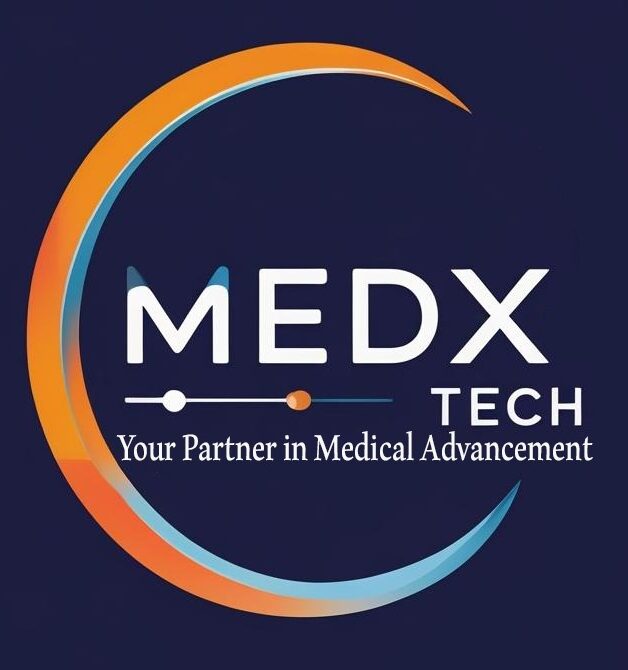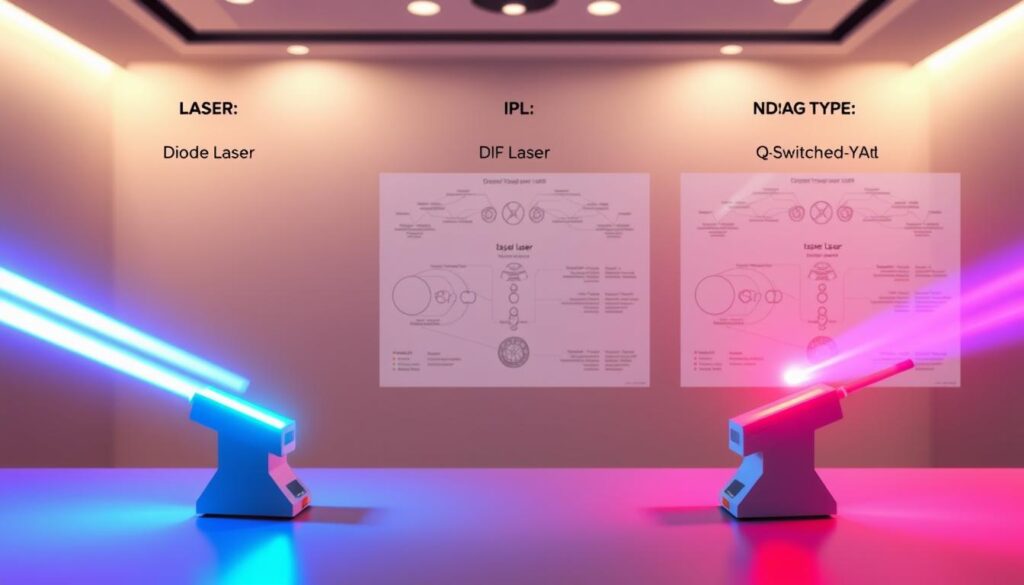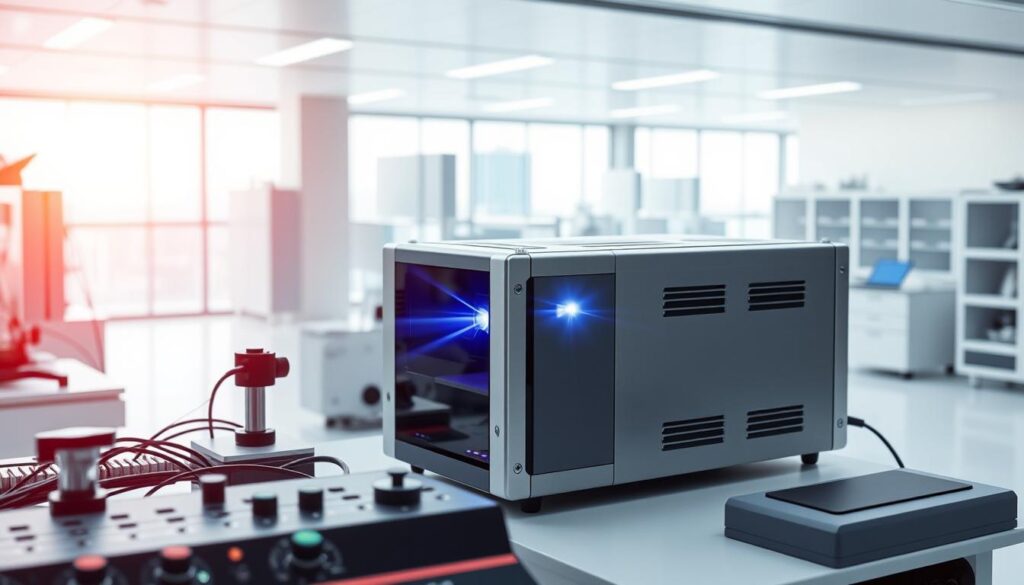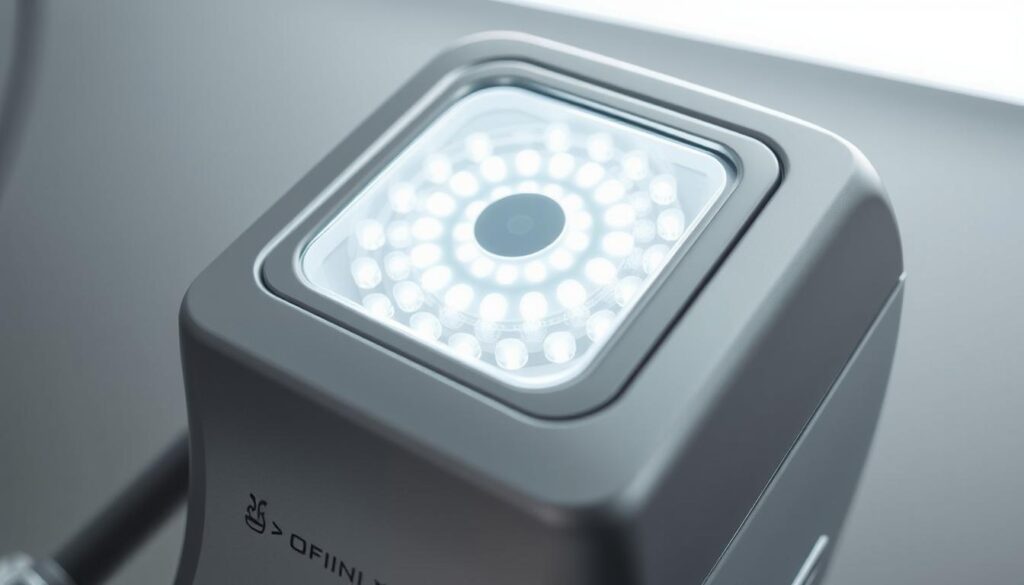Diode Laser vs. IPL vs. Q-Switched ND:YAG: Selecting the Optimal Device
What is the best technology for cosmetic dermatology? There are many options, making it hard to choose. We’ll look at the differences between laser technologies to guide professionals.
It’s important to know how these technologies work and what they’re used for. We’ll go into detail about each one. This will help professionals pick the best device for their work.
Key Takeaways
- Understanding the differences between laser technologies is crucial for optimal results.
- Comparative analysis helps practitioners choose the right device.
- Core mechanisms and applications vary across technologies.
- Selecting the optimal device depends on specific needs.
- Practitioners must stay updated on the latest advancements.
Understanding Laser and Light-Based Technologies
Laser and light-based technologies are key in modern cosmetic dermatology. They have changed the game, offering treatments for many skin issues.
Basic Principles of Cosmetic Laser Treatments
Cosmetic laser treatments use selective photothermolysis. This means specific light wavelengths target skin problems, causing the desired effect. Laser technology is precise, treating areas carefully without harming nearby skin.
How These Technologies Interact with Skin
The way lasers and lights interact with skin is intricate. The device’s wavelength, pulse duration, and fluence affect its success. For example, lasers can remove hair or treat dark spots.
Key Differences in Mechanism of Action
Diode lasers, IPL, and Q-switched ND:YAG lasers work differently. Knowing these differences helps choose the right treatment for each need. Diode lasers are great for hair removal, while Q-switched ND:YAG lasers are best for tattoos.
Understanding laser and light-based technologies helps practitioners choose the best treatments for their patients.
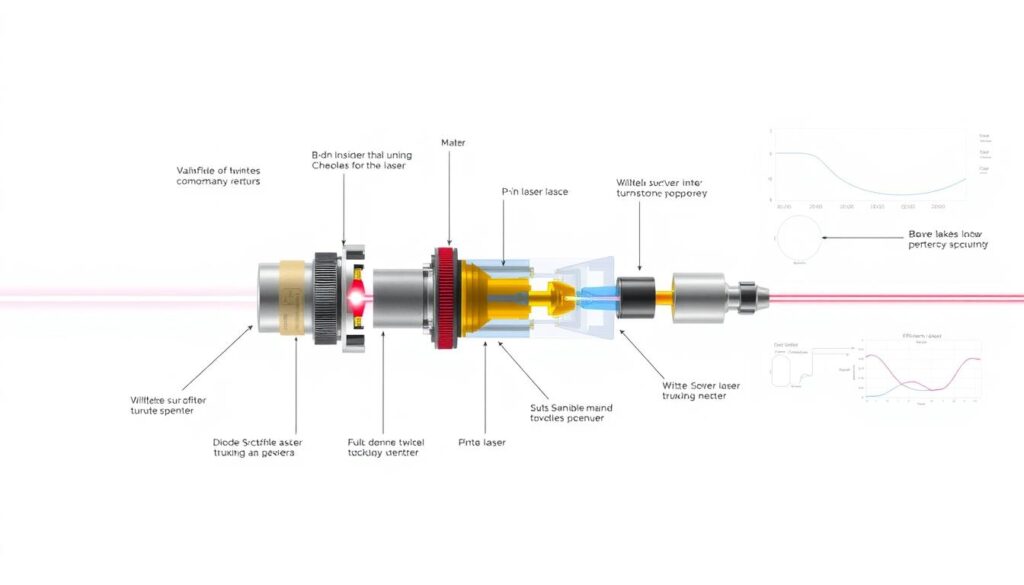
Diode Laser Technology: Core Mechanisms and Applications
Diode lasers are a top pick in dermatology for their accuracy and effectiveness. They’re used for many cosmetic treatments, like hair removal and skin renewal.
How Diode Lasers Work
Diode lasers send out a specific light wavelength that hits the hair follicle or skin issue. The diode laser tech is made to target skin chromophores without harming nearby tissue.
Wavelength Specifications and Tissue Targeting
The wavelength of a diode laser is key to its use. Different wavelengths tackle different skin problems, making diode lasers versatile for many treatments.
Common Cosmetic Applications
Diode lasers are often used for laser hair removal and skin renewal. Their success in these areas has made them a key part of dermatology services.
Hair Removal Efficiency
The diode laser is great for hair removal because it precisely targets the hair follicle. This leads to lasting hair reduction.
Skin Rejuvenation Capabilities
Diode lasers are also used for skin renewal. They boost collagen production and enhance skin texture.
| Application | Benefits | Results |
| Hair Removal | Long-lasting reduction, precision targeting | Smooth skin, reduced hair growth |
| Skin Rejuvenation | Collagen stimulation, improved texture | Younger-looking skin, reduced fine lines |
IPL (Intense Pulsed Light) Technology Explained
IPL is different from laser treatments because it uses a wide range of light. This makes it good for many skincare treatments. It can handle several skin problems at once, making it a flexible choice.
Differentiating IPL from True Lasers
IPL sends out light across a wide spectrum, from 500 to 1200 nanometers. This lets it tackle different skin issues. Lasers, on the other hand, focus on one specific wavelength. This makes IPL great for treating many skin problems, like red spots and dark spots.
Spectrum of Light and Treatment Capabilities
IPL’s wide light spectrum helps it tackle various skin issues. It can handle redness, dark spots, and unwanted hair. By adjusting filters, doctors can customize treatments for each patient. This makes IPL a key tool in beauty treatments.
Versatility in Aesthetic Treatments
IPL’s big plus is its flexibility. It’s good for:
- Photorejuvenation, making skin look better by reducing wrinkles.
- Fixing vascular lesions, like spider veins and birthmarks.
- Dealing with pigmented lesions, such as freckles and dark spots.
Photorejuvenation Benefits
IPL boosts collagen, making skin look smoother and younger. It’s a great way to fight aging without surgery.
Treating Vascular and Pigmented Lesions
IPL targets specific skin problems, like red spots and dark marks. This makes skin look more even and healthy.
Q-Switched ND:YAG: Technology and Mechanisms
In the world of laser treatments, Q-Switched ND:YAG technology is a standout. It’s used a lot in cosmetic dermatology for its precision and results. It’s great for treating many skin issues.
Q-Switching Technology Explained
Q-Switching lets lasers send out high-energy pulses very quickly, in nanoseconds. This helps target pigmented spots and tattoos well without harming nearby skin. The Q-Switched ND:YAG laser builds up energy and then releases it in a strong pulse.
ND:YAG Wavelength Properties
The ND:YAG laser uses a 1064 nm wavelength, which is near-infrared. This wavelength goes deep into the skin, perfect for treating deep spots and tattoos. It also doesn’t absorb much melanin, which helps avoid skin damage.
Target Chromophores and Tissue Interactions
The Q-Switched ND:YAG laser targets melanin and tattoo ink. Its high-energy pulses break these down into smaller pieces. The body then removes these pieces, fading or removing spots and tattoos.
Tattoo Removal Capabilities
The Q-Switched ND:YAG laser is great for removing tattoos, especially those with blue and black ink. It can reach deep into the skin, making it a top choice for tattoo removal.
Pigmentation Treatment Efficacy
This laser is also good for treating pigmented spots like melasma and nevus of Ota. It’s been shown to reduce pigmentation and improve skin in clinical studies.
Key Benefits:
- Effective for tattoo removal and pigmentation treatment
- Minimal risk of epidermal damage due to its wavelength
- High-energy pulses for efficient chromophore targeting
Diode Laser vs. IPL vs. Q-Switched ND:YAG — Choosing the Right Device for Your Cosmetic Needs
Choosing between diode laser, IPL, or Q-switched ND:YAG technology is crucial. It depends on understanding their differences and how well they work. You need to look at how they work, their results, and how safe they are.
Key Technological Differences
The main difference is in their wavelength specificity and pulse duration. Diode lasers target specific areas with a single wavelength. IPL devices use a broad spectrum for more applications but might be riskier. Q-switched ND:YAG lasers are best for tattoos and pigmented spots because of their high power and short pulses.
Treatment Efficiency Comparison
Diode lasers are top for hair removal because they work fast and well. IPL devices are good for many issues but might need more sessions. Q-switched ND:YAG lasers are great for tattoos and spots, needing fewer treatments.
Safety Profile Comparison
Safety levels differ. Diode lasers are safe for darker skin when used right. IPL devices are riskier, especially for darker skin, because of their wide spectrum. Q-switched ND:YAG lasers are safe for most but need careful settings to avoid risks.
Clinical Evidence and Efficacy Studies
Many studies have looked at how well these technologies work. Diode lasers are excellent for hair reduction over time. IPL devices are good for skin renewal and vascular issues. Q-switched ND:YAG lasers are effective for tattoos and spots.
In summary, picking the right device is all about understanding the tech, how well it works, safety, and research. This way, professionals can choose what’s best for their clients.
Hair Removal Capabilities: Technology Comparison
Many technologies have been developed for hair removal, like diode laser, IPL, and Q-switched ND:YAG. Each has its own strengths and weaknesses for removing hair.
Diode Laser Efficiency for Hair Removal
Diode lasers are very good at removing hair because they target the hair follicle precisely. They work best for people with darker hair because they focus on the melanin in the hair follicle. This leads to less hair growing back after several treatments.
IPL Hair Removal Applications
IPL systems are also popular for hair removal. They cover more area quickly but aren’t as precise as diode lasers. IPL works for different skin types, but its success depends on hair color and skin tone.
Limitations of Q-Switched ND:YAG for Hair Removal
Q-switched ND:YAG lasers aren’t usually used for hair removal. They’re better for removing pigmented lesions and tattoos because of their short pulses. They can remove hair, but they’re not as good as diode lasers and IPL for this task.
Treatment Protocols and Optimal Settings
Getting the best hair removal results means choosing the right treatment and settings. For diode laser and IPL, things like fluence, pulse duration, and cooling systems are key. Adjusting these can make a big difference in how well the treatment works.
Skin Rejuvenation and Anti-Aging Treatments
More and more people are looking for effective skincare treatments. It’s important to know how different technologies work for the best anti-aging results. Skin rejuvenation and anti-aging treatments are very popular, each with its own benefits.
Collagen Stimulation Capabilities
Diode lasers and Q-switched ND:YAG lasers are great at making more collagen. This is important for looking young and having radiant skin. Collagen stimulation also makes skin more elastic and reduces wrinkles.
Treatment of Fine Lines and Wrinkles
IPL treatments can help with many skin issues, like fine lines, wrinkles, and uneven skin tone. Its ability to target different skin colors makes it a good choice for overall skin care.
Skin Tightening Effects
Diode lasers are especially good at tightening skin. They go deep into the skin to make collagen and tighten it up.
Comparative Results and Patient Satisfaction
| Technology | Collagen Stimulation | Skin Tightening | Patient Satisfaction |
| Diode Laser | High | High | 90% |
| IPL | Moderate | Moderate | 85% |
| Q-Switched ND:YAG | High | Low | 80% |
Studies show diode lasers are top for collagen and skin tightening. This leads to very happy patients.
Tattoo Removal and Pigmentation Treatment Efficacy
Q-switched ND:YAG lasers have changed tattoo removal and pigmentation treatment. They are precise and effective for removing unwanted tattoos and treating pigmentation issues.

Q-Switched ND:YAG for Professional and Amateur Tattoos
The Q-switched ND:YAG laser works well for both professional and amateur tattoos. It targets the ink without harming the skin, making it great for tattoo removal.
Targeting Different Ink Colors
Different ink colors react differently to laser treatments. The Q-switched ND:YAG laser is best for black and dark blue inks, which are often used in tattoos.
Comparing Technologies for Melasma and Hyperpigmentation
Choosing the right technology is key for treating melasma and hyperpigmentation. The table below shows how different lasers compare for these conditions.
| Technology | Melasma Treatment Efficacy | Hyperpigmentation Treatment Efficacy |
| Q-Switched ND:YAG | High | High |
| IPL | Moderate | Moderate |
| Diode Laser | Low | Low |
Treatment Sessions and Expected Outcomes
The number of sessions needed varies by case and technology. Usually, several sessions are required for the best results.
Key Takeaway: The Q-switched ND:YAG laser is top-notch for tattoo removal and pigmentation treatments. It offers precise targeting and minimal side effects.
Skin Type Considerations and Fitzpatrick Scale Compatibility
When giving dermatology services, it’s key to think about a client’s skin type and Fitzpatrick scale. The Fitzpatrick scale sorts skin into six types. It looks at how sensitive skin is to sunlight and the risk of burning.
Safety for Darker Skin Tones
Darker skin tones (Fitzpatrick IV-VI) face a higher risk of skin color changes from laser treatments. Q-Switched ND:YAG lasers are safer for these skin types. They have a longer wavelength, which lowers the chance of bad reactions.
Technology Recommendations by Skin Type
Each skin type needs its own laser and light treatment plan. For example, IPL works best for fair skin (Fitzpatrick I-III). On the other hand, Diode Lasers can work for a wider range of skin types.
| Skin Type | Recommended Technology | Risk Level |
| I-III | IPL, Diode Laser | Low |
| IV-VI | Q-Switched ND:YAG | Moderate to High |
Risk of Hyperpigmentation and Hypopigmentation
The risk of skin color changes varies with skin type and treatment. It’s important for practitioners to know these risks. They should take steps to avoid them.
Customizing Treatments for Different Ethnicities
It’s vital to tailor treatments for different ethnicities. Practitioners need to understand each client’s skin. This way, they can give personalized care.
Pain Levels, Downtime, and Recovery Comparison
Different laser technologies have unique profiles for pain and recovery. It’s important for both doctors and patients to understand these differences. This helps in making better choices.
Patient Comfort During Treatments
Patient comfort varies a lot between diode laser, IPL, and Q-switched ND:YAG treatments. Diode lasers are often in the middle for pain levels. On the other hand, IPL treatments are less painful because they use a broader spectrum and less concentrated energy.
Post-Treatment Recovery Periods
Recovery times vary among these technologies. Diode lasers need very little downtime. But, Q-switched ND:YAG lasers might need more care after treatment because of their high-energy pulses.
Managing Side Effects
Managing side effects well is crucial for patient comfort. This includes good post-treatment care and sometimes using pain management strategies.
Pain Management Strategies
Strategies include using topical anesthetics, cooling devices, and adjusting treatment settings. A comparison of these technologies is shown in the table below.
| Technology | Pain Level | Downtime | Recovery Management |
| Diode Laser | Moderate | Minimal | Topical creams, cooling |
| IPL | Low to Moderate | Minimal | Cooling, gentle skincare |
| Q-Switched ND:YAG | High | Variable | Topical anesthetics, post-care creams |
Cost Analysis and Return on Investment for Practitioners
Investing in laser and light-based devices needs a close look at costs and benefits. Practitioners must weigh the financial side before adding these technologies to their practice.
Device Acquisition and Maintenance Costs
The cost of starting with laser and light-based devices is high. Prices vary based on the technology and brand. For example, diode lasers and Q-Switched ND:YAG lasers are pricier than IPL systems.
Maintenance costs add up over time. This includes parts and service fees. “Keeping these devices running can be costly,” experts say.
Treatment Pricing Strategies
Creating a good pricing plan is key to making money. Practitioners must think about treatment costs, their target market, and what others charge. Package deals and membership programs can draw in and keep customers, boosting income.
Long-Term Business Considerations
Thinking about the future is important when choosing laser and light-based tech. Consider market demand, new tech, and the chance to offer more services. Multi-technology platforms are flexible and can meet changing needs, making them a smart long-term choice.
Multi-Technology Platforms vs. Specialized Devices
Choosing between multi-technology platforms and specialized devices depends on several things. These include the services offered, what clients want, and your budget. Specialized devices are great for certain treatments, but multi-technology platforms offer flexibility and can save money by reducing the need for many devices.
In summary, a detailed cost analysis and thinking about the return on investment are crucial for those considering laser and light-based technologies. By understanding the costs of devices, setting good prices, and looking at the long-term, practitioners can make smart choices that help their business grow.
Conclusion: Making the Optimal Technology Selection
Choosing the right laser technology is key for good results in cosmetic treatments. We’ve compared diode laser, IPL, and Q-switched ND:YAG. Each has its own way of working, uses, and benefits.
When picking between these lasers, think about what your practice needs and the treatments you offer. This helps you make the best choice for your patients.
Deciding on the right laser means looking at how well it works, its safety, and how happy patients are. Knowing what each laser can do helps you make smart choices. This improves your practice and makes patients happier.
The best laser for you depends on your practice’s needs and goals. Look at the differences in technology and the evidence. This ensures the laser you choose fits your practice’s goals.
FAQ
What are the main differences between diode laser, IPL, and Q-switched ND:YAG technologies?
Diode lasers are great for hair removal and skin renewal. IPL treats many skin issues like photorejuvenation and vascular problems. Q-switched ND:YAG is top for tattoo removal and treating pigmentation.
Which technology is best for hair removal?
Diode lasers are the best for hair removal. They target hair follicles very well.
Can IPL be used for tattoo removal?
No, IPL isn’t good for tattoo removal. Q-switched ND:YAG lasers are better because they target tattoo ink.
Are these technologies safe for all skin types?
These technologies work on many skin types. But, Q-switched ND:YAG is safer for darker skin. Always check your skin type before treatment.
How many sessions are required for tattoo removal with Q-switched ND:YAG?
Tattoo removal sessions depend on the tattoo’s size, color, and depth. Also, your skin type matters. You’ll likely need more than one session.
What are the common side effects of laser and light-based treatments?
Side effects include redness, swelling, and temporary color changes. Taking good care before and after treatment can help.
How do I choose the right device for my cosmetic practice?
Look at the technology’s action, how well it works, safety, and research. Think about what you need and what your clients want.
What is the cost analysis for acquiring and maintaining these devices?
Costs vary a lot based on the technology, brand, and model. Remember to consider the initial cost, upkeep, supplies, and training.
Can these technologies be used for skin rejuvenation and anti-aging treatments?
Yes, diode lasers, IPL, and Q-switched ND:YAG can help with skin rejuvenation. They boost collagen, reduce wrinkles, and improve skin texture.
